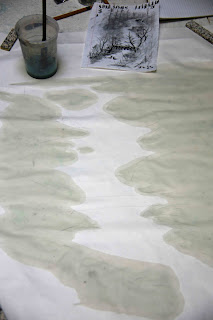Now that I could see the finish line, I'm having second thoughts.
I am leery that pink might be too flashy.
There's only one way to find out. I painted a couple of test swatches, one in pink and the other Blue Hue Three.
The blue looked nice and seemed to blend in well with the rest of the scenery. Hence the problem. It blended in too well and the painting looked ....uninviting.
The pink was uplifting and definitely grabbed my attention. It worked well as a punctuation mark! Now the fat lady sings!
The bamboo areas in the left midriff portion seemed a little flat. I tried to paint in a few more leaves but that looked really cluttered and was concealing my brushstrokes, so I backed off. I settled on selectively darkening certain areas to give it a lumpy look, to get more depth in that cluster.
The creek still looked too open ended for me. I would like the bottom part to close off some more. I also wanted to warm up the foreground somewhat, to subtly draw it out further from the background. Harking back to Photoshop tricks, I decided to add a warming filter by painting a very diluted and light yellow color over the lower half of the landscape, and the bottom end of the creek. I was hoping the slight yellow tint on the water might work as a gradient tool to help narrow the creek somewhat.
I decided to add a few ducks to this painting, or rather, to move them to different coves as compared with the original draft. It seems like I couldn't do a painting anymore without adding a bird or heron or something. In this case, that's what Beaverton Creek is all about. A nature park in a city.
One of the things I like about this painting is that there are so many points of interest in it.
It invites you to explore each little snippet, to "read" the painting, as Chinese would say.
Some of these sections could stand in as a complete painting in its own right.
I need to hang this up now and glance at it occasionally. I'm sure something will come up for me to make corrections.









































